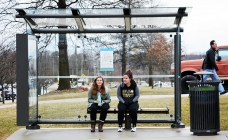Friday mornings often resemble a surge of crowds headed to their early classes or opening shift. However, one recent Friday morning in Baltimore city, many commuters were surprised to be turned around when encountering a sign reading:
“THIS STATION IS TEMPORARILY CLOSED”
On Sunday, the Maryland Transit Administration announced that the Baltimore Metro SubwayLink system will be closed for an estimated month due to emergency repairs. After a safety inspection conducted on underground tracks in the Northwest region, MTA declared the transportation system to be out of commission until conditions improve.
However, the condition of Baltimore residents who depend on riding the rails will also need alleviating. On the MTA’s online data portal, they have recorded the average weekday ridership per month is at 50,000. But of course, these numbers do not speak for the tremendous effect this change will have on residents these next few weeks.
In reaction to this disparity, Governor Larry Hogan has utilized $2.2 million in emergency funds to provide a shuttle bus service to operate while Metro SubwayLink is down.
What seems to be the most unfortunate matter of these circumstances is the suddenness of it all. A UMBC employee and Baltimore native, Devin Hanson shared, “It’s just not fair. I know they’re doing everything they can but what I have no way of knowing that.” The confusion and frustration that Hanson experiences reflects the same attitude of many individuals in under-resourced communities.
Countless civilians share a mutual understanding that the administration is taking precautionary measures. Still, they also believe it was their responsibility to take preventative measures as well.
Officials and politicians have gone back and forth over who should be held accountable. Deputy Transportation Secretary James F. Ports Jr. stated at a Monday hearing before the House Appropriations subcommittee that, “There was a neglect throughout the system, so we are picking up where they left off.” Although we suspect who is involved in this great infrastructure decline, the problem persists. In retrospect, the immediate response that travelers were expecting may equate to this weekend’s shutdown.
Metro, which was established in 1983, would undoubtedly expect to face technicalities in the long-term. To combat this development, Hogan’s administration promised to instate a $135 million BaltimoreLink Program. This initiative, which was proposed over the summer of 2017, was meant to instrument a customer-focused transit system that would better meet the needs of city residents.
The needs of Baltimore resident, Tihira Turrell, have yet to be met.
“It’s really disappointing. Now, I have to borrow a car from one of my family members to get to work and drop them off at work on the way. I don’t know how long I can keep this up,” Turrell stated in a brief interview.
How we approach such issues is dependent on finances, resources, etc. But the value system we have in place is more important. The deterioration of the rail system is far worse than anyone predicted and a failure of the system.
Another downtrend follows in discovering that the bus service scheduled to run the Metro’s route has yet to launch. The MTA had not distributed information specifically about where the buses would stop or when they would arrive. The appropriate call to action may not be clear cut but it must be on time, else resident Turrell will continue to suffer.
Turrell later stated, “We were told that the metro would be closed for a weekend, and somehow it’s now closed until March.”
The inconvenience caused by a lack of public transportation is significant. As commuters pass by Lexington Market station, the temporarily closed sign will remain hanging along with the balance of their daily lives. A temporary solution is always welcome, but like Baltimore residents, it should be here to stay.

